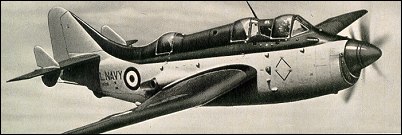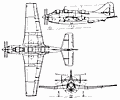 |
Fairey Gannet1949 |  |
| NAVAL MULTI-PURPOSE | Virtual Aircraft Museum / United Kingdom / Fairey |
 |
Built to the requirements of a carrier-based anti-submarine warfare (ASW) aircraft, Fairey's prototype was known initially as the Type Q. It flew for the first time on 19 September 1949. This and the second prototype were of two-seat configuration, but the third prototype (which first flew on 10 May 1951) was more representative of production aircraft with three cockpits to accommodate the pilot (forward), observer/navigator (centre), and radio-radar operator (aft). Of all-metal stressed-skin construction, this large mid-wing monoplane had mechanically folding wings to facilitate carrier stowage. Aptly named Gannet, for its deep fuselage was able to swallow and carry all its major strike weapons internally, this was very much a 'first and last' aircraft. An outstanding feature was its Armstrong Siddeley Double Mamba turboprop engine, comprising two turbine engines with individual co-axial contra-rotating propellers; it was the first aircraft in the world to fly with such a power plant. Either engine could be shut down independently and its propeller feathered so that the aircraft could cruise economically on patrol. When power was needed for take-off and combat, both engines were available. It was also the first aircraft in FAA service to combine the 'hunter/killer' role for ASW. Previously, a 'hunter' aircraft had located the target for a 'killer' to attack, but the problems posed by communication and rendezvous clearly reduced efficiency. The Gannet enabled a specialist team to work together. As mentioned above, it was able to carry its major strike weapons internally, the first British-built operational naval aircraft with such capability. Up to 16 air-to-surface rockets could be carried beneath the wings. The first operational squadron was formed on 17 January 1955. AS.1 and AS.4 aircraft, as well as T.2 and T.5 trainers, served with the FAA until gradually superseded by Whirlwind helicopters from 1958. On 1 February 1960 the Gannet AEW.3 early-warning variant began to enter service, having a more powerful Double Mamba engine and a large radome mounted beneath the fuselage. Its pilot was accommodated in a forward cockpit and the two radar operators were seated within the fuselage. A total of 44 of these were built, the later examples by Westland Aircraft which took over the Fairey factories in 1960. The AEW.3 which went to sea aboard HMS Ark Royal in the summer of 1970 were the last Fairey-designed first-line aircraft to serve with the FAA.
|  COMPANY PROFILE | ||||||||||||||||||||||||||||||||||||||||||||||||||||||
 |

|

